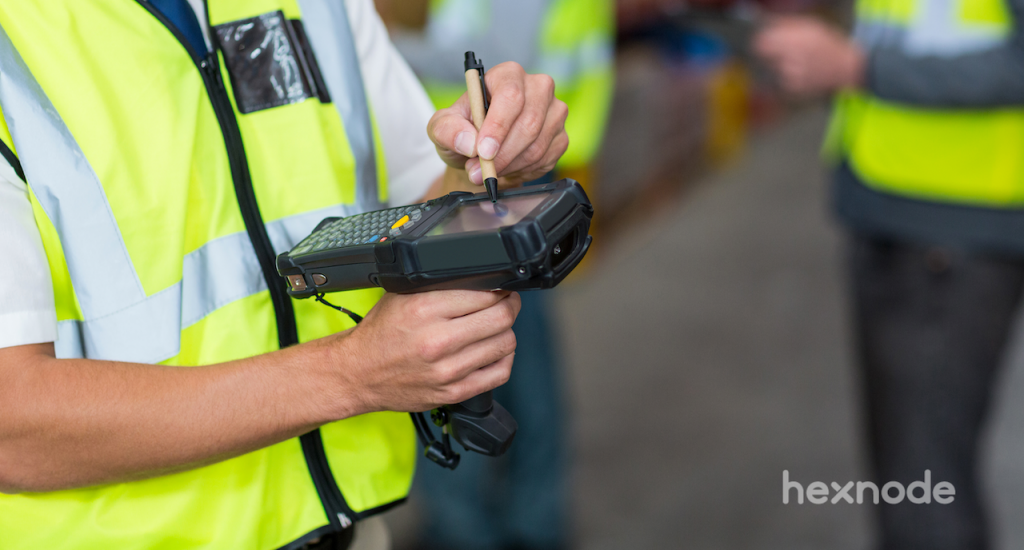The absolute Guide to Unified Endpoint Management(UEM) in Enterprise
Completely equip yourself with the basic knowledge of the what, how and why of the UEM in an enterprise.

Get fresh insights, pro tips, and thought starters–only the best of posts for you.
Andrei Geralt
Mar 16, 2021
10 min read

Technology has advanced to a point where almost all devices are linked regardless of what platform they run on, whether it be a standard (Like iOS, Android) or non-standard platform. If you refer to the devices as ‘Things’, then yes, we are talking about the Internet of Things (IoT). IoT is a trend that has caught up to every industry, which, in turn, creates a necessity to manage the devices used in them. With Hexnode’s IoT device management, almost every component in the network can be centralized.
If an entire digital system is inter-connected, there is a need to track, secure and manage all the devices in the network. With Enterprises adopting the concept of IoT workplace, IoT device management has seen rapid development. The growth in the educational sector, economics and the high demand for IoT development are the stimulating factors for the growth of IoT device management. Hexnode’s deep commitment to simplify the management of any device has routed it onto the path to IoT device management.
After entering the fray with Apple TV management in 2017, Hexnode has released more and more features to give it an extra edge over its fellow competitors. By supporting Fire OS and OEM Config Apps, Hexnode gained some authority over managing android displays and offering restrictive policies for industrial and rugged devices. By using modern UEM solutions like Hexnode, the process of deploying and configuring the devices would be a breeze. We can also remotely manage the device from a centralized location. With more future ventures in mind, Hexnode strives to ease your IT admin’s workload.
Check out the various IoT device management features offered by Hexnode.
TRY OUT HEXNODEApple probably never thought its Apple TV would be used in offices since it was initially intended to be a commercial product; To be used in people’s homes as a replacement to cable TVs. Surprisingly enough, it somehow made its way into board rooms as a corporate presentation tool and as digital signages for advertising. Apple TV also supports more management features after the release of tvOS 10.2, allowing enterprises to manage the device through their management portal. Hexnode integrated features to support TvOS after realizing its growing significance and popularity.
Digital signages are a popular and entertaining way to advertise a brand or business. Small businesses, however, might not go for them owing to its complex deployment and expensive maintenance. But with Hexnode, any store can go for digital signages. By locking the TV to a single app and coupling it with Airplay configurations, we can ensure the smooth implementation of digital signages. Apple TV is also a popular choice as a presentation screen in board rooms. Hexnode can configure the device for the said role by utilizing the Airplay and the Conference room feature. Bulk deployment of tvOS is no different from iOS or macOS since Hexnode’s integration with Apple Business Management(ABM) also supports Apple TV promising a plain sailing deployment. From conference room displays to Digital signages, Hexnode can help you configure your Apple TV for a particular task seamlessly.
Before talking about an OEM Config App, we need to understand what exactly is a managed app configuration. When an app developer creates an app, it can be made such that it supports app configuration. The developer can specify the various options a UEM can configure within the app itself. Using a UEM like Hexnode, we can configure the app to behave in the way we want it to behave.
Okay, Back to OEMConfig Apps. When we talk about android devices, you’d be imagining smartphones, tablets, and so on. So on? Are you sure there are more? Mobile Computers, Printers, Barcode scanners, RFID readers, etc., all run on Android. Enlightening. But then again, unlike an android phone or tablet, configuring these devices via a UEM can’t be easy. That’s why OEM (Original Equipment Manufacturers) release OEMConfig Apps.
With OEMConfig apps, UEM providers can apply managed configurations on their devices. So the steps for configuring a device via OEMConfig App are pretty simple. You install the OEMconfig app either manually or by using a UEM like Hexnode. Using the Hexnode portal, you can customize the options in the OEMConfig App. Then voila, your device is configured. Hexnode supports top OEM Vendors such as Samsung, Honeywell, Zebra and Kyocera. From managing legacy android devices to deploying devices in bulk, Hexnode aims to provide a complete device management solution.

When you enter a store, you wouldn’t be surprised if you find digital signages there. They have grown quite popular over the past decade and is still expected to keep it up. The digital signage market is expected to grow up to 27.8 billion USD by 2026. There are various displays we can use as signages, with Android TV being one of the popular choices because, well…because its Android! And with Hexnode supporting any device from Android 2.0, Smart TVs are no exception.
Deploying Smart TVs can’t get any easier with Hexnode’s no touch enrollment. After the initial set up, you can remotely manage and view the device, eliminating a need for onsite maintenance and troubleshooting. With features like custom playlist, extensive multimedia support and immense scalability, you can style your digital signages without constraints.
Fire OS is pretty much Android without Google support. Released by Amazon as the operating system for its mobile devices, it offers its own alternatives to google apps. What’s so great about it? For starters, it’s more economical and a simpler version of Google Android devices. If you are looking for a tablet with a more straightforward interface yet advanced enough to act as an android device, then Amazon Tablets are what you are looking for.
By late January in 2020, Hexnode UEM announced its support for Amazon Fire OS services. Hexnode already supports a very extensive set of configurations for Android-based devices, and since Fire OS is built on Android, most of its configurations are supported. Fire OS devices can be used for various purposes like as a kiosk and as digital signage. Utilizing Hexnode, you get many additional configurations when kiosk locking your device, such as enabling screensavers, remote viewing, enabling lost mode and so on. Fire OS devices are an excellent choice as digital signages because of their low cost, so almost any business can afford them. With Hexnode at the helm, deploying signages are super easy, and by utilizing the various features available, you can let loose your creativity and make your digital signage more attractive.

If you are going to manage a whole network of devices, then obviously, you’ll need to manage the most used user endpoints; Smartphones and Laptops. You can significantly reduce the probability of a data breach and increase your workforce’s efficiency by managing the devices with a UEM.
Leading UEM providers like Hexnode supports iOS, Android, MacOS, Windows, FireOS and tvOS. By supporting multiple platforms, organizations using a wide variety of devices would not require any additional management tool to manage their devices.
Hexnode adopts various facets of mobility management to efficiently manage and secure your devices.
It’s important to keep your endpoints secure, unless you want to experience a setback because of a data breach. Hexnode offers various features such as encryption, auto-locking of devices and tracking to prevent the device from being accessed by the wrong person. And with the business containerization, Hexnode separates the employee’s personal and work data, preventing any accidental leaks.
Wouldn’t it be great if you could import your user directory or device directory from one platform to another? Hexnode has essential integrations with popular platforms such as G-Suite, Azure Directory, Apple Business Manager, Microsoft AD, Zendesk and Okta.
Hexnode provides various features ranging from the basic restrictions like blacklisting applications to advanced options such as Web app kiosk restrictions. By utilizing the various features of a UEM, you can quickly deploy and manage all the devices used by the employees in your enterprise.
There is no doubt that the market for IoT device management would grow over the years, with reports estimating that the market would reach 7.20 Billion USD by 2026. With more and more devices being used in the workplaces, it’s only natural that enterprises would be turning to IoT. A report from IDC predicts that by 2026, total number of IoT connections per minute will reach 152,200. The more the devices, the harder it is to manage them using conventional MDM solutions. Also, some smart devices do not operate under a standard operating system, which makes UEM solutions almost useless. The only way to manage this vast number of devices is to turn to IoT device management.
Since IoT device management is still developing, Hexnode is meticulously researching and implementing new technologies, which could significantly reduce the workload in managing all devices.
When business productivity takes center stage, the compliance needs of the enterprise are often forgotten, which is why we will continue to invest in building products that inspire positive change in information security processes.
– Apu Pavithran, CEO at Hexnode
IoT would continue to grow more and more advanced, and who knows, almost every device in an enterprise would be interlinked in the near future. This scenario would significantly complicate managing devices, but Hexnode’s vision will always remain the same: To simplify device management.